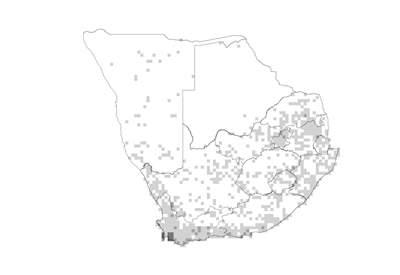 Species distribution and density. Darker squares represent higher density of members of this family. |
Introduction
Thesium family
Although members of this family are not always noticed in the veld or bush, they are quite common once you start looking out for them. On the Highveld the small herbs and trees have a characteristic blue-green colour, but they take on all shapes and sizes in the Western Cape.
Distribution
Widespread in subtropical and temperate regions, often in drier areas, frequently in grassland. A high diversity of species is found in the Western Cape.
Number of genera in the world
36
Number of species in the world
500
Number of genera in the Flora of southern Africa region
5
Number of species in the Flora of southern Africa region
187
Well-known southern African genera
Osyris, Thesium, Thesidium
Growth forms
Herbs, shrubs or trees, often hemiparasitic on roots.
Habitats
In grassveld, fynbos and bushveld.
Flagship species
Thesium capitatum is one of the more attractive Thesium species. It forms a compact, very densely leafy shrublet that flowers all year round. The leaves are ericoid with a sharp tip, and the small white flowers are borne in heads at the branch ends. It is restricted to the southern Cape coastal areas.
Significance of the family
The best known member that characterises the family is not found naturally in South Africa although products of *Santalum album (sandalwood tree) are sold commercially. The wood is fragrant, and wooden objects are often sold as scent balls. Sandalwood oil is commonly used in the cosmetics and fragrance industries. Osyris species produce bright orange, red or black fruit that are sought after by birds.
Diagnostic characters
Usually parasitic on roots of other plants. Leaves alternate or occasionally opposite, greyish or bluish green and leathery . Flowers small without petals, with 3-6 greenish-white sepals ; anthers with a tuft of hair. Fruit a nut or drupe , often sticky or brightly coloured and distributed by birds.
Did you know?
Sandalwood holds its fragrance for many years and is one of the oldest incense materials-it has been used for more than 4 000 years.